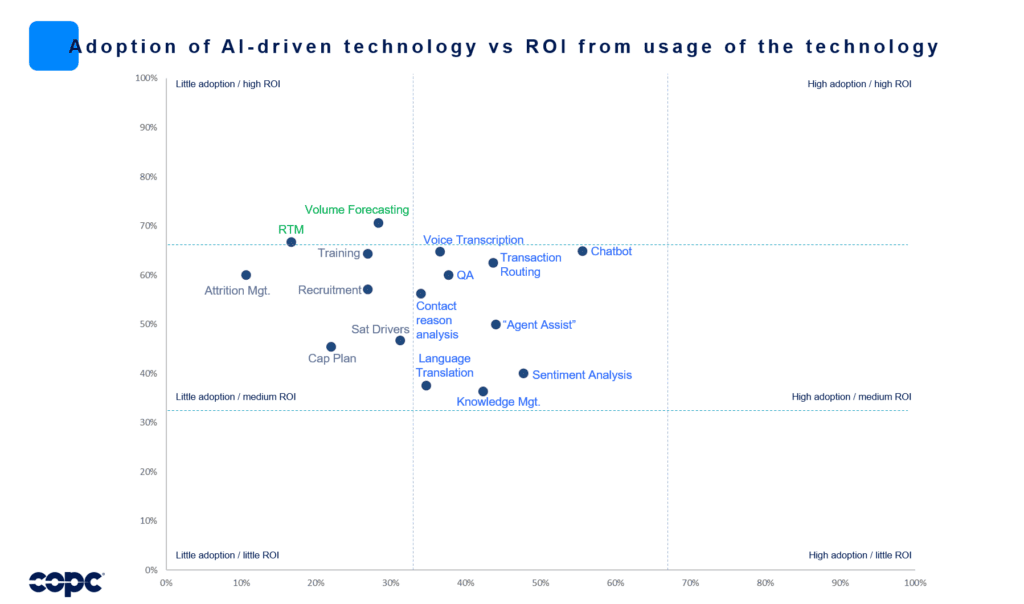
September 23, 2024
Amid the constant shifts in contact centers and customer service, the allure of technological solutions often draws our focus. One AI-powered tool that has gained widespread use is sentiment analysis, designed to gauge customer emotions and improve service delivery.
However, despite its popularity, many executives remain unconvinced of its value. We conducted proprietary research for the COPC Standards Committee, which reveals that only around 40% of contact center leaders report seeing a meaningful return on investment from sentiment analysis tools.

A recent experience with one of our Australian clients highlights this issue. They had invested in a sophisticated sentiment analysis tool to measure customer satisfaction in nearly real-time.
At first glance, the data seemed promising, projecting positive outcomes. However, something didn’t quite add up, leading us to take a closer look. When we compared the tool’s results with actual customer feedback surveys, we found a striking and concerning discrepancy in the first instance we examined.
The customer’s survey clearly depicted dissatisfaction—an unresolved issue and growing frustration. Yet, our sentiment analysis tool cheerfully reported the interaction as “positive” and “resolved.” Talk about a reality disconnect!
This experience underscored the importance of considering the broader context of customer service. The sentiment analysis tool, while sophisticated, was operating with tunnel vision. It analyzed the phone call in isolation, missing the broader context.
The call center agent had promised to escalate the issue and arrange a callback. The customer was happy that, finally, it appeared as though someone would take their issue seriously. The tool interpreted this as a positive outcome.
However, a quick look into the company’s CRM system revealed that the callback never happened, leaving the customer’s problem unresolved.
This experience taught us several valuable lessons:
- The customer experience is frequently part of an intricate service journey, not an isolated incident.
- Promises to customers are sacred – breaking them can transform a seemingly positive interaction into a negative one.
- While sentiment analysis tools can be useful, they shouldn’t be our sole barometer of customer satisfaction.
The COPC Customer Experience (CX) Standard, the world’s leading standard for excellent customer service, advocates for a more comprehensive approach. It emphasizes the need to gather feedback from multiple sources:
- Customer complaints
- Observations of customer interactions
- Satisfaction surveys
- Feedback from frontline staff
- Computer analysis of calls and messages
- Social media posts
- Online reviews
- Group discussions with customers
- Advisory meetings with key customers
Each source provides unique insights into the customer’s mindset and experience.

Related
CX Technology Consulting
Fusing technology and expertise to design and deliver exceptional service journeys.
Gathering the data is just the beginning. The COPC CX Standard encourages careful analysis to uncover the reasons behind customer inquiries. It also emphasizes evaluating satisfaction at each touchpoint and understanding how these touchpoints fit into the overall service journey. Ultimately, the goal is to identify the key factors driving customer satisfaction throughout their entire experience.
The final and most critical step is turning these insights into action. Running a high-performance operation requires more than just identifying issues—we must act quickly.
For problems within our control, swift resolution is key. For those outside the contact center’s reach, it’s about ensuring other departments have the information they need to address the issue effectively.
Relying solely on sentiment analysis is like judging a book based on just one page. Genuinely improving customer service requires embracing the broader approach outlined in the COPC CX Standard.
We can only accurately picture the customer experience and make meaningful improvements by considering the full range of customer feedback. After all, in the world of customer service, the customer’s perspective is the ultimate truth—even when our advanced tools tell us otherwise.

Ian Aitchison is the CEO of COPC Inc. for the Asia Pacific region, boasting over 20 years of expertise in customer contact operations across Asia and Australia. Based in Sydney, Ian has significantly enhanced operational strategies and customer experience for many leading global brands.
Ian is an expert in sectors ranging from technology to insurance and a senior auditor for the COPC CX Standard. Ian holds a BA in Legal Studies from Napier University and is a qualified Six Sigma trainer.